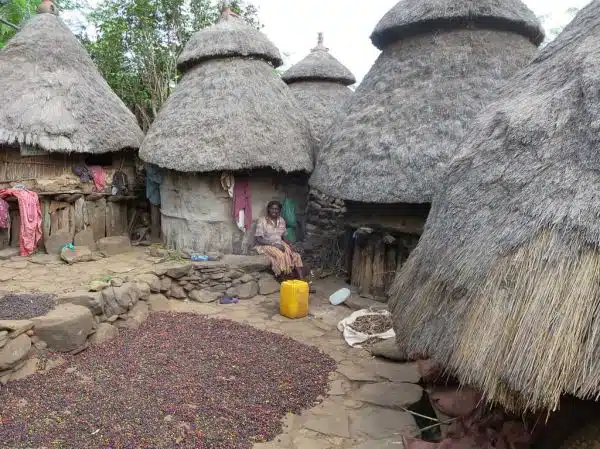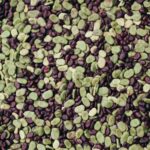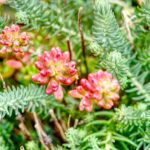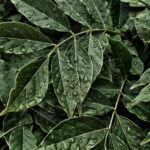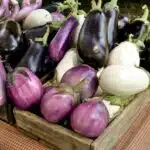Dry beans are a valuable source of protein, fiber, and other essential nutrients that are necessary for maintaining human health. As a plant agriculture specialist, it is my pleasure to share the knowledge on how to grow and harvest dry beans. Growing your own dry beans is not only rewarding but also cost-effective compared to buying them from grocery stores.
To ensure a successful bean crop, one must understand the biology of the plant and its growth requirements. Dry beans prefer well-drained soil with a pH range between 6.0-6.5 and full sun exposure for optimal growth. Proper timing of planting is crucial as beans require warm soil temperatures above 60°F to germinate and thrive. In this article, we will explore the different types of dry beans suitable for home gardens, planting techniques, pest management strategies, and harvesting methods that will help you achieve maximum yields while ensuring quality produce for your family or community’s consumption.
The Nutritional Benefits Of Dry Beans
Dry beans are a highly nutritious food source that can offer many health benefits. They are low in fat and high in protein, making them an excellent choice for vegetarians or those looking to reduce their meat consumption. Additionally, they contain complex carbohydrates that provide sustained energy levels throughout the day.
Cooking techniques for dry beans vary depending on the type of bean and personal preference. Some popular methods include soaking overnight before cooking, pressure cooking, or adding them to soups and stews. It is important to note that while canned beans are convenient, they often contain added sodium and preservatives, so it is recommended to use dried beans whenever possible.
Incorporating dry beans into your diet can improve overall health by reducing the risk of heart disease, diabetes, and certain types of cancer. They are also a good source of fiber which aids in digestion and helps regulate blood sugar levels. In the next section, we will delve into understanding the biology of dry bean plants and how to grow them effectively for optimal harvest yields.
Understanding The Biology Of Dry Bean Plants
Dry bean plants are fascinating organisms that go through a series of developmental stages before they can be harvested. Understanding plant growth is crucial in ensuring optimal nutrient uptake in dry beans. During the vegetative stage, the plant grows leaves and roots, which facilitate the absorption of essential nutrients such as nitrogen, phosphorus, and potassium from the soil. The reproductive stage is characterized by flower formation followed by pod development containing mature seeds.
Factors affecting dry bean yield and quality include environmental conditions such as temperature, moisture availability, and soil fertility. Dry beans require adequate moisture during the early growth stages for optimal root development. Soil fertility plays an essential role in determining plant growth and productivity since it influences nutrient availability. Temperature also affects plant growth since dry beans thrive in warm weather with temperatures ranging between 18-27°C.
In summary, understanding the biology of dry bean plants is critical in maximizing their yield potential. Nutrient uptake during different growth stages is essential in promoting healthy plant growth and development. Environmental factors such as moisture availability, soil fertility, and temperature affect dry bean yield and quality. In the following section, we will discuss how to choose the right variety of dry beans for your garden to optimize productivity further.
Choosing The Right Variety Of Dry Beans For Your Garden
Selecting the right variety of dry beans for your garden is crucial to achieving a successful harvest. When choosing a variety, consider factors such as climate, soil type, and desired yield. Some varieties may be better suited for cooler climates while others can tolerate heat and drought better. Additionally, certain types of soil may be more conducive to growing specific varieties.
Gardening tips for selecting the right variety of dry beans include researching the different options available and consulting with local experts or agricultural extension offices. These resources can provide valuable information on which varieties have performed well in your area and which ones may be more susceptible to pests or diseases. It is also important to choose a variety that fits your gardening goals, whether that be high yields or unique flavor profiles.
To assist in selecting the appropriate dry bean variety for your garden, refer to the table below which lists popular types of dry beans along with their characteristics and recommended growing conditions:
| Bean Variety | Characteristics | Recommended Growing Conditions |
|---|---|---|
| Black Beans | Rich flavor | Warm weather |
| Navy Beans | Mild flavor | Cooler climate |
| Kidney Beans | Meaty texture | Well-drained soil |
| Lima Beans | Butter-like | Hot weather |
By carefully selecting the right variety of dry beans for your garden and following proper gardening tips, you can ensure a bountiful harvest. In the next section, we will discuss how to prepare your soil for planting dry beans. By taking these steps before planting, you will set yourself up for success in growing healthy and hearty plants that produce plentiful yields.
Preparing Your Soil For Dry Bean Planting
Soil preparation is a crucial step in growing dry beans. Before planting, it is important to ensure that the soil is rich in nutrients and has good drainage. This can be achieved by adding compost to the soil. Composting techniques such as vermicomposting, where worms are used to break down organic matter, can be used to create nutrient-rich compost.
To prepare your soil for planting dry beans, first remove any weeds or rocks from the area. Then, till the soil to a depth of at least six inches. Next, add a layer of compost to the soil and mix it in thoroughly. If you don’t have access to compost, consider using other natural amendments such as bone meal or blood meal.
Proper soil preparation will help your dry bean plants thrive and produce a bountiful harvest. Once your soil is prepared, you can move on to planting your dry beans. Continue reading for more information on when and how to plant your dry beans.
When And How To Plant Your Dry Beans
As you prepare to plant your dry beans, picture the ideal planting conditions. The soil is rich and warm with a gentle breeze carrying the smell of freshly tilled earth. Planting your beans at the right time and in the right conditions is crucial for ensuring a bountiful harvest.
Best practices for planting dry beans include choosing a sunny spot with well-draining soil. Avoid planting in areas where water tends to pool or in areas that receive less than six hours of sunlight per day. Common mistakes include planting too deep or too shallow, which can cause poor germination rates or damage to young plants.
Ideal planting conditions:
- Soil temperature between 60-70°F
- Adequate moisture without overwatering
- Planting after all danger of frost has passed
Troubleshooting tips:
- If seedlings appear yellowish, they may be lacking nitrogen
- If leaves curl under or turn brown, it may indicate lack of water
- If plants are stunted or yellow, they may have been planted too deeply
Now that you know when and how to plant your dry beans, it’s time to focus on watering and fertilizing them. By following best practices and avoiding common mistakes, you’ll be on your way to growing healthy plants and harvesting a successful crop.
Watering And Fertilizing Your Dry Beans
Adequate amounts of water is essential for successful growth of dry beans; 1 inch per week of rainfall or irrigation is recommended. Fertilizing dry beans should be done with a balanced fertilizer containing nitrogen, phosphorus and potassium. The amount of fertilizer used should be based on soil type and crop needs. Frequency of fertilizer application should be determined by the growth stage of the crop and the amount of available soil moisture. In general, early season applications are recommended as the beans are actively growing. Late season applications should be avoided as they can cause lodging, which can result in yield loss. In some cases, a mid-season application may be beneficial.
Water Amount
Developing the right watering strategy for your dry beans is crucial to ensure a successful harvest. An optimal watering schedule should be followed to provide the plants with enough moisture without causing overwatering that can lead to root rot and pest infestations. It is important to note that dry beans are drought-tolerant, so they do not require as much water as other crops.
To determine the optimal watering schedule for your dry beans, you need to consider factors such as soil type, weather conditions, and stage of growth. Generally, young seedlings require frequent watering until their roots establish into the soil. As they mature, reduce the frequency of watering but increase the amount of water per session. Avoid overhead irrigation to prevent wetting the leaves and promote fungal diseases.
Overwatering can cause severe damage to your dry bean plants. Too much water in the soil can suffocate plant roots due to a lack of oxygen supply, leading to stunted growth or even death. Overly moist conditions also attract pests such as slugs, snails, and rodents that can feed on the tender shoots and leaves. Be mindful of how much water you give your dry beans and make sure that their soil has adequate drainage to avoid these issues.
Fertilizer Types
A successful dry bean harvest requires proper watering and fertilizing. While we have discussed the importance of an optimal watering schedule in the previous subtopic, it is equally important to choose the right fertilizer for your dry beans. There are two main types of fertilizers: organic and synthetic. Organic fertilizers are derived from natural sources such as animal manure, bone meal, and compost. Synthetic fertilizers, on the other hand, are formulated chemically to provide specific nutrients.
When choosing a fertilizer for your dry beans, consider its dosage and application. The recommended dosage of fertilizer depends on various factors such as soil type, plant growth stage, and nutrient deficiencies. Over-fertilizing can lead to excessive vegetative growth at the expense of flower and pod development. Applying too much fertilizer can also cause salt buildup in the soil that can harm plant roots.
To apply fertilizer, spread it evenly around the base of each plant while avoiding direct contact with leaves or stems. Water immediately after applying to help distribute the nutrients into the soil. It is important to note that both organic and synthetic fertilizers have their pros and cons. Organic fertilizers promote soil health by improving its structure and fertility over time but may take longer to release nutrients into plants. Synthetic fertilizers provide quick-acting nutrients but can harm beneficial microorganisms in the soil when used excessively.
In summary, choosing the right type of fertilizer for your dry beans is crucial to maximize yields while maintaining soil health. Consider factors such as dosage and application when applying either organic or synthetic fertilizers to avoid over-fertilization that can damage plant growth or pollute waterways through runoff.
Fertilizer Frequency
Fertilizer frequency is another important factor to consider when watering and fertilizing your dry beans. The frequency of fertilizer application depends on the type of fertilizer used, soil conditions, and plant growth stage. Organic fertilizers typically require less frequent applications as they release nutrients slowly over time. Synthetic fertilizers, on the other hand, may require more frequent applications as they provide quick-acting nutrients that are easily absorbed by plants.
When it comes to choosing the best fertilizer brands for your dry beans, there are various options available in both organic and synthetic forms. Some popular organic brands include Espoma, Dr. Earth, and Jobe’s Organics. These brands offer a range of products that are derived from natural sources such as bone meal, blood meal, and compost. For synthetic fertilizers, some popular brands include Miracle-Gro, Scotts Turf Builder, and Vigoro. These brands offer products that are formulated chemically to provide specific nutrients.
Regardless of the type of fertilizer brand you choose for your dry beans, it is important to follow the recommended frequency of application. Over-fertilization can lead to nutrient imbalances that can harm plant growth or cause environmental pollution through runoff. By choosing the right type of fertilizer brand and applying it at the right frequency based on soil conditions and plant growth stage, you can ensure optimal yields while maintaining soil health for future harvests.
Managing Pests And Diseases In Your Dry Bean Crop
After providing your dry bean crop with adequate watering and fertilization, it is crucial to manage pests and diseases that may pose a threat to their growth. Integrated pest management (IPM) is an effective approach that can help you identify, prevent, and control pests while minimizing harm to the environment.
The first step in IPM is monitoring your crop regularly to detect any signs of pests or diseases. Early detection allows for quick action before the problem escalates. You can also use natural remedies such as neem oil, garlic spray, or insecticidal soap to control pests without harming beneficial insects like bees and ladybugs.
Another aspect of IPM is preventing future pest problems by practicing good agricultural practices such as crop rotation and maintaining healthy soil. Healthy plants are less susceptible to pest infestations than weak ones. In addition, using resistant varieties of dry beans can reduce the incidence of diseases.
Managing pests and diseases in your dry bean crop requires a holistic approach that takes into account environmental factors and human behavior. By incorporating IPM strategies such as regular monitoring, natural remedies, and prevention measures, you can ensure a healthy harvest while minimizing harm to the environment. In the next section, we will discuss weed control in your dry bean garden.
Weed Control In Your Dry Bean Garden
Ah, weeds. The uninvited guests that show up in our gardens and refuse to leave. They seem to have a knack for surviving and thriving despite all odds. But fear not, my fellow dry bean growers! There are ways to control these pesky plants without resorting to harmful chemicals.
One technique is integrated pest management, which involves using a combination of methods to control pests and weeds. This approach includes everything from physical barriers like row covers to biological controls like companion planting. Speaking of which, did you know that certain plants can help keep weeds at bay? For example, planting marigolds alongside your dry bean plants can help repel nematodes and other harmful insects while also suppressing weed growth.
Another effective weed control method is mulching. By placing a layer of organic material like straw or leaves around your plants, you can prevent weed seeds from germinating while also retaining moisture in the soil. Plus, as the mulch breaks down over time, it will add valuable nutrients back into the soil.
Now that we’ve covered some ways to control weeds in your dry bean garden, let’s move on to another important step: mulching your dry bean plants.
Mulching Your Dry Bean Plants
After taking care of weed control in your dry bean garden, it’s time to move on to the next step: mulching. Mulching is the practice of covering the soil around your plants with organic or inorganic material. There are many benefits to mulching, including reducing water loss through evaporation, suppressing weed growth, and regulating soil temperature.
Choosing the right mulch for your dry beans is crucial. Organic mulches like straw, leaves, or grass clippings can help improve soil quality as they decompose over time. Inorganic mulches like plastic or fabric can also be used but may not provide the same soil benefits as organic materials. When choosing a mulch for your dry beans, consider factors such as cost, availability, and climate.
Applying mulch is easy – simply spread a layer of material around each plant on top of the soil. Be sure to leave a gap between the stem of each plant and the start of the mulch layer to prevent rotting. As your dry beans grow taller and begin to produce pods, you may need to add more mulch to keep them off the ground and prevent damage from pests or diseases. By properly mulching your dry bean plants, you’ll help ensure healthy growth and a bountiful harvest.
Transitioning into staking and supporting your dry bean plants, it’s important to note that proper support can further increase yields by improving air circulation and light exposure while also preventing damage from wind or heavy rain.
Staking And Supporting Your Dry Bean Plants
As your dry bean plants start to grow, it is important to provide them with support. Staking and supporting your plants not only prevents damage from wind or heavy rain but also helps increase your yield. There are different types of stakes available for use, including bamboo stakes and metal poles. Whichever type of stake you choose, make sure it is sturdy enough to hold up the weight of the plant.
Another option for supporting your dry bean plants is using natural supports such as trellises, fences or even other plants. These natural supports can not only be aesthetically pleasing but they can also provide shade for the roots during hot summer months. When choosing a natural support system, make sure that they are strong enough to hold up the weight of the plant when it is fully grown.
Providing proper support for your dry bean plants is crucial in ensuring a successful harvest. However, this isn’t the only thing you need to consider when caring for your plants. The next section will discuss proper pruning techniques that can help increase yields and reduce disease potential in your crop.
Proper Pruning Techniques For Your Dry Beans
Pruning is an essential practice in growing healthy and productive dry beans. Pruning benefits the plant by removing unnecessary parts, which can be a source of disease or pests. It also encourages the growth of new branches that will bear more pods. When done correctly, pruning can increase the yield of your dry bean crop.
One important pruning technique for dry beans is removing the suckers or side shoots that grow from the base of the stem. These suckers compete with the main stem for nutrients and water, resulting in smaller yields. Removing them will allow the main stem to grow stronger and healthier, leading to more significant and fuller pods.
Another effective pruning technique is pinching off the top of the main stem when it reaches a certain height. This practice stimulates lateral branching, leading to more pod production. Be sure to pinch off only a few inches at a time and avoid cutting too close to young leaves, as this may damage them.
Now that you know about proper pruning techniques for your dry beans, you are one step closer to a bountiful harvest. But before you reap what you sow, it’s essential to know when and how to harvest your crop properly. In the next section, we’ll discuss everything you need to know about harvesting dry beans for optimal yield and quality.
When And How To Harvest Your Dry Beans
Once your dry bean plants have matured, it is time to harvest them. Signs of readiness include the drying of leaves and pods, as well as a change in color from green to yellow or brown. Before harvesting, it is important to check the weather forecast and choose a dry day for the task.
To begin harvesting your dry beans, use pruning shears or scissors to cut the entire plant at soil level. Allow the plants to dry completely before proceeding with post-harvest processing. This can take up to two weeks in warm, dry weather conditions.
Post-harvest processing involves removing the beans from their pods and separating any debris. This can be done by hand or using specialized equipment such as threshers or winnowers. Once complete, store your harvested dry beans in a cool, dry place until you are ready to move on to drying and storing them properly.
As you’ve successfully harvested your dry beans, it’s time now to move on to the next step – drying and storing them. But before that, make sure that your harvested beans are free from any moisture content as this could lead to mold growth or insect infestation. In order to do so, allow them some more time under sun exposure before moving forward with drying and storing techniques which will be discussed further in the upcoming section about ‘Drying and Storing Your Harvested Dry Beans’.
Drying And Storing Your Harvested Dry Beans
When and How to Harvest Your Dry Beans is an essential step in the process of growing dry beans. After harvesting your crop, you need to store them correctly to ensure that they stay fresh for as long as possible. Storing methods and preservation techniques play an essential role in keeping your crop fresh while also preventing pests and mold from damaging it.
The first step in storing dry beans is to make sure that they are completely dry before placing them in storage containers. You can achieve this by leaving your harvested dry beans out in the sun or drying them with a dehydrator. Once they are fully dried, store them in airtight containers such as glass jars or plastic bags. Be sure to label each container with the date of harvest so that you can keep track of how long the beans have been stored.
Preservation techniques such as freezing or canning are also great ways to store dry beans for extended periods. Freezing will preserve the flavor and nutritional value of your dry beans, but it may impact their texture if not done correctly. Canning is a popular preservation method because it allows you to store large amounts of dry beans for long periods without losing their quality or nutritional value. Proper storage and preservation techniques will ensure that you have delicious, fresh-tasting dry beans all year round.
To prepare your stored dry beans for cooking and consumption, soak them overnight in water to rehydrate them before cooking. You can then use them in recipes such as soups, stews, chilies, or salads. With proper storage and preservation techniques, you can enjoy the benefits of growing and harvesting your own dry beans all year round.
Preparing Your Dry Beans For Cooking And Consumption
After growing and harvesting your dry beans, it is important to properly prepare them for consumption. One crucial step in this process is soaking the beans. Soaking helps to remove some of the indigestible sugars that can cause discomfort and gas when consumed. There are two primary methods for soaking dry beans: overnight soaking or quick soaking. Overnight soaking involves covering the beans with water and leaving them to soak for at least 8 hours, while quick soaking involves boiling the beans for a few minutes and then letting them sit in hot water for an hour.
Once your beans have been soaked, it’s time to cook them. There are a variety of cooking techniques that can be used depending on personal preference and recipe requirements. Some popular options include boiling, pressure cooking, slow cooking, and baking. Regardless of the method chosen, it is important to ensure that the beans are cooked thoroughly to avoid any potential digestive issues.
Properly preparing your dry beans not only improves their flavor and texture but also ensures that they are safe to consume. By experimenting with different soaking methods and cooking techniques, you can discover new ways to enjoy this versatile ingredient in your meals.
- Soaking is an essential step in preparing dry beans for consumption.
- Overnight soaking or quick soaking are two primary methods for soaking.
- Cooking techniques vary depending on preference and recipe requirements.
- Boiling, pressure cooking, slow cooking, and baking are all popular options.
- Thoroughly cooked beans are essential to avoid digestive issues.
Output transitioning into the subsequent section:
By properly preparing your harvested dry beans through soaking methods and cooking techniques it enhances their flavor ensuring safety before consumption. Once you have prepared your harvest adequately you can share these nutritious ingredients with others in your community through various means such as donating or even hosting a meal using these freshly harvested dry beans as a staple ingredient.
Sharing Your Dry Bean Harvest With Others In Your Community
After properly preparing your dry beans, it is time to share the harvest with others in your community. Community outreach is an essential aspect of sustainable agriculture practices. By sharing your yield, you not only build stronger relationships with those around you but also promote food security and healthy eating habits. Encourage your neighbors to start growing their own dry beans by offering them a few seeds or cuttings from your plants.
One way to engage with your community is through a recipe exchange. Share some of your favorite dishes that use dry beans as their main ingredient and ask others to do the same. This simple yet effective practice promotes cultural diversity and encourages people to explore new tastes and flavors. In addition, it helps reduce food waste by providing inspiration for using leftovers or neglected ingredients.
By sharing your dry bean harvest with others, you contribute to building a stronger, healthier community. You can organize a potluck dinner where everyone brings a dish made with dry beans or donate some of your yield to a local soup kitchen or food bank. These small gestures can make a big impact on the lives of those around you while promoting sustainable agriculture practices and encouraging healthy eating habits.
Conclusion
Dry beans are a nutritious and versatile food crop that can be easily grown and harvested in your own garden. Understanding the biology of dry bean plants and choosing the right variety for your soil type and climate is crucial to achieving a successful harvest. Proper soil preparation, planting, and harvesting techniques are also essential to ensure a bountiful yield.
When it comes to drying and storing your harvested dry beans, it is important to follow proper procedures to prevent spoilage and maintain their nutritional value. Preparing your dried beans for cooking and consumption requires soaking them overnight before cooking them thoroughly.
In conclusion, growing and harvesting dry beans can be a rewarding experience for any home gardener. By following the steps outlined above, you can produce a healthy and sustainable food source for yourself and others in your community. So why not give it a try? Imagine fields of vibrant green bean plants with plump pods ready for harvest – all waiting to provide you with a delicious source of protein, fiber, iron, and other vital nutrients.
Image Credits
- “Coffee Beans Drying” by D-Stanley (featured)

